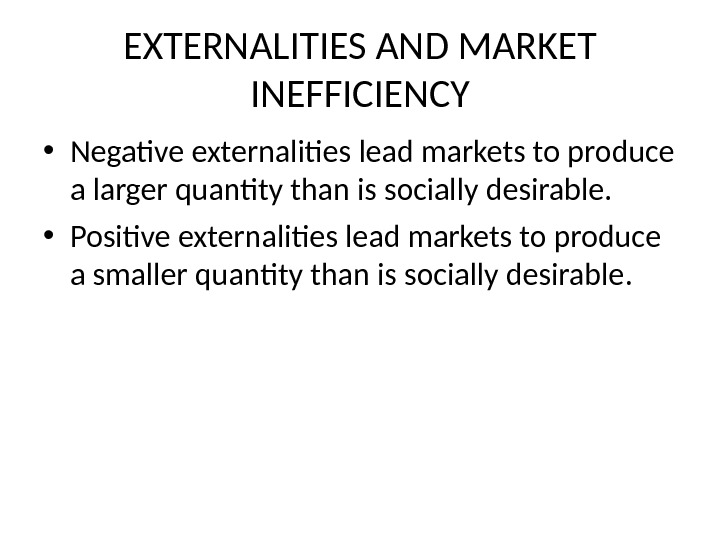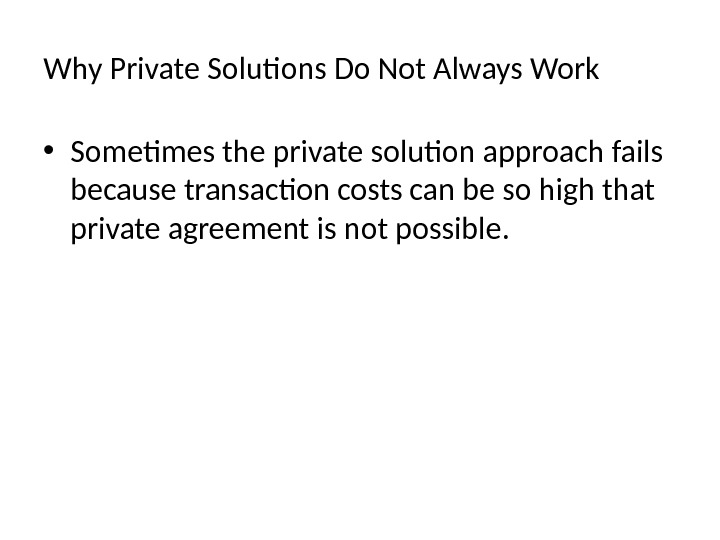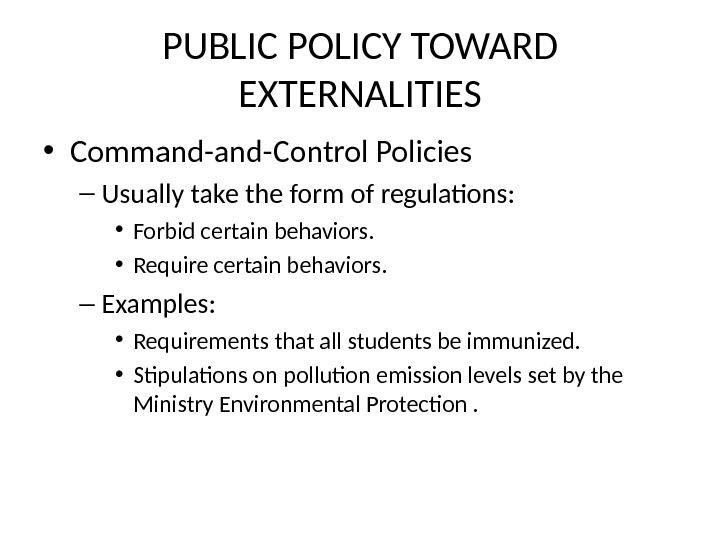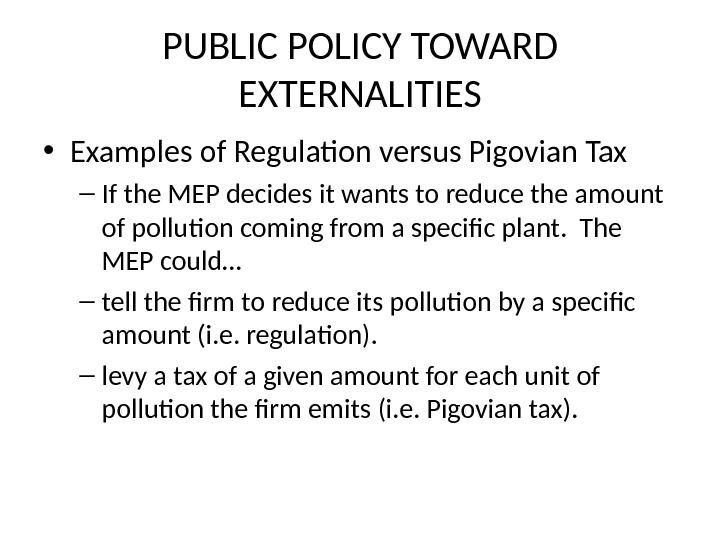THE ECONOMICS OF THE PUBLIC SECTOR Externalities



































- Размер: 357.5 Кб
- Количество слайдов: 34
Описание презентации THE ECONOMICS OF THE PUBLIC SECTOR Externalities по слайдам
 THE ECONOMICS OF THE PUBLIC SECTOR Externalities
THE ECONOMICS OF THE PUBLIC SECTOR Externalities
 Maximized total benefit • Recall: Adam Smith’s “invisible hand” of the marketplace leads self-interested buyers and sellers in a market to maximize the total benefit that society can derive from a market. But market failures can still happen.
Maximized total benefit • Recall: Adam Smith’s “invisible hand” of the marketplace leads self-interested buyers and sellers in a market to maximize the total benefit that society can derive from a market. But market failures can still happen.
 EXTERNALITIES AND MARKET INEFFICIENCY • An externality refers to the uncompensated impact of one person’s actions on the well-being of a bystander. • Externalities cause markets to be inefficient, and thus fail to maximize total surplus.
EXTERNALITIES AND MARKET INEFFICIENCY • An externality refers to the uncompensated impact of one person’s actions on the well-being of a bystander. • Externalities cause markets to be inefficient, and thus fail to maximize total surplus.
 EXTERNALITIES AND MARKET INEFFICIENCY • An externality arises. . . when a person engages in an activity that influences the well-being of a bystander and yet neither pays nor receives any compensation for that effect.
EXTERNALITIES AND MARKET INEFFICIENCY • An externality arises. . . when a person engages in an activity that influences the well-being of a bystander and yet neither pays nor receives any compensation for that effect.
 EXTERNALITIES AND MARKET INEFFICIENCY • When the impact on the bystander is adverse, the externality is called a negative externality. • When the impact on the bystander is beneficial, the externality is called a positive externality.
EXTERNALITIES AND MARKET INEFFICIENCY • When the impact on the bystander is adverse, the externality is called a negative externality. • When the impact on the bystander is beneficial, the externality is called a positive externality.
 EXTERNALITIES AND MARKET INEFFICIENCY • Negative Externalities – Automobile exhaust – Cigarette smoking – Pollution – Loud stereos in an apartment building
EXTERNALITIES AND MARKET INEFFICIENCY • Negative Externalities – Automobile exhaust – Cigarette smoking – Pollution – Loud stereos in an apartment building
 EXTERNALITIES AND MARKET INEFFICIENCY • Positive Externalities – Immunizations – Restored historic buildings – Research into new technologies
EXTERNALITIES AND MARKET INEFFICIENCY • Positive Externalities – Immunizations – Restored historic buildings – Research into new technologies
 The Market for Aluminum Quantity of Aluminum 0 Price of Aluminum Equilibrium Demand (private value)Supply (private cost) Q MARKET
The Market for Aluminum Quantity of Aluminum 0 Price of Aluminum Equilibrium Demand (private value)Supply (private cost) Q MARKET
 EXTERNALITIES AND MARKET INEFFICIENCY • Negative externalities lead markets to produce a larger quantity than is socially desirable. • Positive externalities lead markets to produce a smaller quantity than is socially desirable.
EXTERNALITIES AND MARKET INEFFICIENCY • Negative externalities lead markets to produce a larger quantity than is socially desirable. • Positive externalities lead markets to produce a smaller quantity than is socially desirable.
 Welfare Economics, An example • The Market for Aluminum – The quantity produced and consumed in the market equilibrium is efficient in the sense that it maximizes the sum of producer and consumer surplus. – If the aluminum factories emit pollution (a negative externality), then the cost to society of producing aluminum is larger than the cost to aluminum producers.
Welfare Economics, An example • The Market for Aluminum – The quantity produced and consumed in the market equilibrium is efficient in the sense that it maximizes the sum of producer and consumer surplus. – If the aluminum factories emit pollution (a negative externality), then the cost to society of producing aluminum is larger than the cost to aluminum producers.
 Welfare Economics: An example • The Market for Aluminum – For each unit of aluminum produced, the social cost includes the private costs of the producers plus the cost to those bystanders adversely affected by the pollution.
Welfare Economics: An example • The Market for Aluminum – For each unit of aluminum produced, the social cost includes the private costs of the producers plus the cost to those bystanders adversely affected by the pollution.
 Pollution and the Social Optimum Copyright © 2004 South-Western. Equilibrium Quantity of Aluminum 0 Price of Aluminum Demand (private value) Supply (private cost) Social cost Q OPTIMUMOptimum Cost of pollution Q MARKET
Pollution and the Social Optimum Copyright © 2004 South-Western. Equilibrium Quantity of Aluminum 0 Price of Aluminum Demand (private value) Supply (private cost) Social cost Q OPTIMUMOptimum Cost of pollution Q MARKET
 Negative Externalities • The intersection of the demand curve and the social-cost curve determines the optimal output level. – The socially optimal output level is less than the market equilibrium quantity.
Negative Externalities • The intersection of the demand curve and the social-cost curve determines the optimal output level. – The socially optimal output level is less than the market equilibrium quantity.
 Negative Externalities • Internalizing an externality involves altering incentives so that people take account of the external effects of their actions.
Negative Externalities • Internalizing an externality involves altering incentives so that people take account of the external effects of their actions.
 Negative Externalities • Achieving the Socially Optimal Output • The government can internalize an externality by imposing a tax on the producer to reduce the equilibrium quantity to the socially desirable quantity.
Negative Externalities • Achieving the Socially Optimal Output • The government can internalize an externality by imposing a tax on the producer to reduce the equilibrium quantity to the socially desirable quantity.
 Positive Externalities • When an externality benefits the bystanders, a positive externality exists. – The social value of the good exceeds the private value.
Positive Externalities • When an externality benefits the bystanders, a positive externality exists. – The social value of the good exceeds the private value.
 Positive Externalities • A technology spillover is a type of positive externality that exists when a firm’s innovation or design not only benefits the firm, but enters society’s pool of technological knowledge and benefits society as a whole.
Positive Externalities • A technology spillover is a type of positive externality that exists when a firm’s innovation or design not only benefits the firm, but enters society’s pool of technological knowledge and benefits society as a whole.
 Education and the Social Optimum Copyright © 2004 South-Western Quantity of Education 0 Price of Education Demand (private value) Social value. Supply (private cost) Q MARKET Q OPTIMUM
Education and the Social Optimum Copyright © 2004 South-Western Quantity of Education 0 Price of Education Demand (private value) Social value. Supply (private cost) Q MARKET Q OPTIMUM
 Positive Externalities • The intersection of the supply curve and the social-value curve determines the optimal output level. – The optimal output level is more than the equilibrium quantity. – The market produces a smaller quantity than is socially desirable. – The social value of the good exceeds the private value of the good.
Positive Externalities • The intersection of the supply curve and the social-value curve determines the optimal output level. – The optimal output level is more than the equilibrium quantity. – The market produces a smaller quantity than is socially desirable. – The social value of the good exceeds the private value of the good.
 Positive Externalities • Internalizing Externalities: Subsidies – Used as the primary method for attempting to internalize positive externalities. • Industrial Policy – Government intervention in the economy that aims to promote technology-enhancing industries • Patent laws are a form of technology policy that give the individual (or firm) with patent protection a property right over its invention. • The patent is then said to internalize the externality.
Positive Externalities • Internalizing Externalities: Subsidies – Used as the primary method for attempting to internalize positive externalities. • Industrial Policy – Government intervention in the economy that aims to promote technology-enhancing industries • Patent laws are a form of technology policy that give the individual (or firm) with patent protection a property right over its invention. • The patent is then said to internalize the externality.
 PRIVATE SOLUTIONS TO EXTERNALITIES • Government action is not always needed to solve the problem of externalities.
PRIVATE SOLUTIONS TO EXTERNALITIES • Government action is not always needed to solve the problem of externalities.
 PRIVATE SOLUTIONS TO EXTERNALITIES • Moral codes and social sanctions • Charitable organizations • Integrating different types of businesses • Contracting between parties
PRIVATE SOLUTIONS TO EXTERNALITIES • Moral codes and social sanctions • Charitable organizations • Integrating different types of businesses • Contracting between parties
 The Coase Theorem • The Coase Theorem is a proposition that if private parties can bargain without cost over the allocation of resources, they can solve the problem of externalities on their own. • Transactions Costs – Transaction costs are the costs that parties incur in the process of agreeing to and following through on a bargain.
The Coase Theorem • The Coase Theorem is a proposition that if private parties can bargain without cost over the allocation of resources, they can solve the problem of externalities on their own. • Transactions Costs – Transaction costs are the costs that parties incur in the process of agreeing to and following through on a bargain.
 Why Private Solutions Do Not Always Work • Sometimes the private solution approach fails because transaction costs can be so high that private agreement is not possible.
Why Private Solutions Do Not Always Work • Sometimes the private solution approach fails because transaction costs can be so high that private agreement is not possible.
 PUBLIC POLICY TOWARD EXTERNALITIES • When externalities are significant and private solutions are not found, government may attempt to solve the problem through. – command-control policies. – market-based policies.
PUBLIC POLICY TOWARD EXTERNALITIES • When externalities are significant and private solutions are not found, government may attempt to solve the problem through. – command-control policies. – market-based policies.
 PUBLIC POLICY TOWARD EXTERNALITIES • Command-Control Policies – Usually take the form of regulations: • Forbid certain behaviors. • Require certain behaviors. – Examples: • Requirements that all students be immunized. • Stipulations on pollution emission levels set by the Ministry Environmental Protection.
PUBLIC POLICY TOWARD EXTERNALITIES • Command-Control Policies – Usually take the form of regulations: • Forbid certain behaviors. • Require certain behaviors. – Examples: • Requirements that all students be immunized. • Stipulations on pollution emission levels set by the Ministry Environmental Protection.
 PUBLIC POLICY TOWARD EXTERNALITIES • Market-Based Policies – Government uses taxes and subsidies to align private incentives with social efficiency. – Pigovian taxes are taxes enacted to correct the effects of a negative externality.
PUBLIC POLICY TOWARD EXTERNALITIES • Market-Based Policies – Government uses taxes and subsidies to align private incentives with social efficiency. – Pigovian taxes are taxes enacted to correct the effects of a negative externality.
 PUBLIC POLICY TOWARD EXTERNALITIES • Examples of Regulation versus Pigovian Tax – If the MEP decides it wants to reduce the amount of pollution coming from a specific plant. The MEP could… – tell the firm to reduce its pollution by a specific amount (i. e. regulation). – levy a tax of a given amount for each unit of pollution the firm emits (i. e. Pigovian tax).
PUBLIC POLICY TOWARD EXTERNALITIES • Examples of Regulation versus Pigovian Tax – If the MEP decides it wants to reduce the amount of pollution coming from a specific plant. The MEP could… – tell the firm to reduce its pollution by a specific amount (i. e. regulation). – levy a tax of a given amount for each unit of pollution the firm emits (i. e. Pigovian tax).
 PUBLIC POLICY TOWARD EXTERNALITIES • Market-Based Policies • Tradable pollution permits allow the voluntary transfer of the right to pollute from one firm to another. – A market for these permits will eventually develop. – A firm that can reduce pollution at a low cost may prefer to sell its permit to a firm that can reduce pollution only at a high cost.
PUBLIC POLICY TOWARD EXTERNALITIES • Market-Based Policies • Tradable pollution permits allow the voluntary transfer of the right to pollute from one firm to another. – A market for these permits will eventually develop. – A firm that can reduce pollution at a low cost may prefer to sell its permit to a firm that can reduce pollution only at a high cost.
 The Equivalence of Pigovian Taxes and Pollution Permits Quantity of Pollution 0 Price of Pollution Demand for pollution rights. P Pigovian tax(a) Pigovian Tax 2. . which, together with the demand curve, determines the quantity of pollution. 1. A Pigovian tax sets the price of pollution. . . Q
The Equivalence of Pigovian Taxes and Pollution Permits Quantity of Pollution 0 Price of Pollution Demand for pollution rights. P Pigovian tax(a) Pigovian Tax 2. . which, together with the demand curve, determines the quantity of pollution. 1. A Pigovian tax sets the price of pollution. . . Q
 Figure The Equivalence of Pigovian Taxes and Pollution Permits Quantity of Pollution 0 Demand for pollution rights QSupply of pollution permits (b) Pollution Permits Price of Pollution 2. . which, together with the demand curve, determines the price of pollution. 1. Pollution permits set the quantity of pollution. . . P
Figure The Equivalence of Pigovian Taxes and Pollution Permits Quantity of Pollution 0 Demand for pollution rights QSupply of pollution permits (b) Pollution Permits Price of Pollution 2. . which, together with the demand curve, determines the price of pollution. 1. Pollution permits set the quantity of pollution. . . P
 Summary • When a transaction between a buyer and a seller directly affects a third party, the effect is called an externality. • Negative externalities cause the socially optimal quantity in a market to be less than the equilibrium quantity. • Positive externalities cause the socially optimal quantity in a market to be greater than the equilibrium quantity.
Summary • When a transaction between a buyer and a seller directly affects a third party, the effect is called an externality. • Negative externalities cause the socially optimal quantity in a market to be less than the equilibrium quantity. • Positive externalities cause the socially optimal quantity in a market to be greater than the equilibrium quantity.
 Summary • Those affected by externalities can sometimes solve the problem privately. • The Coase theorem states that if people can bargain without a cost, then they can always reach an agreement in which resources are allocated efficiently.
Summary • Those affected by externalities can sometimes solve the problem privately. • The Coase theorem states that if people can bargain without a cost, then they can always reach an agreement in which resources are allocated efficiently.
 Summary • When private parties cannot adequately deal with externalities, then the government steps in. • The government can either regulate behavior or internalize the externality by using Pigovian taxes or by issuing pollution permits.
Summary • When private parties cannot adequately deal with externalities, then the government steps in. • The government can either regulate behavior or internalize the externality by using Pigovian taxes or by issuing pollution permits.

